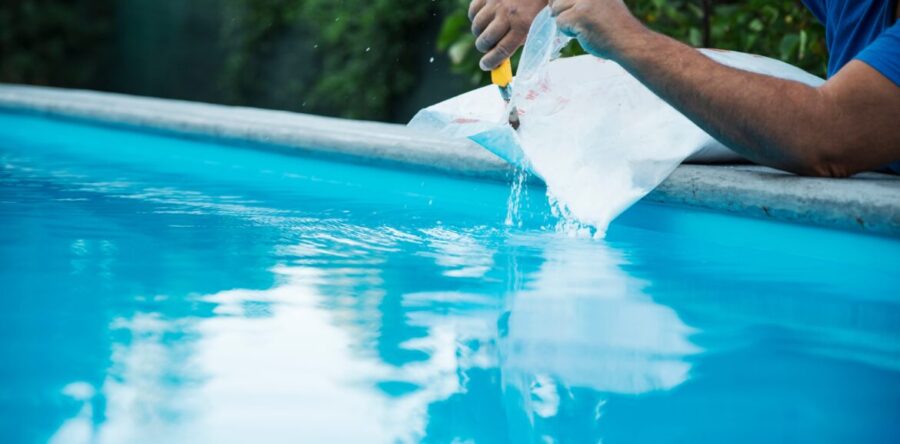Keeping up with hot tub water care is essential if you want clean, safe water every time you soak. But with so many options—like chlorine, saltwater, UV, ozone, and osmosis—it can be hard to know which spa water treatment system is right for you. Whether you’re looking for something low-maintenance, more natural, or budget-friendly, this guide will help you compare the pros and cons of each method so you can enjoy clean spa water without the guesswork.
What’s the Best Way to Keep the Water Purified for Your Hot Tub?
Thoroughly relaxing in the spa starts with consistent hot tub water care that ensures clear, clean and safe water. But you might be asking yourself, “How do I keep it that way? Should I use salt, chlorine, UV, or osmosis to keep my hot tub water crystal clear?”
It can be confusing, because there are a variety of water purification options available to you. Hot tub owners often wonder which method is most effective for maintaining clean spa water, and the quickest and easiest to maintain.
Each system – traditional chlorine, saltwater, UV purification, and osmosis – has its own set of pros and cons. The right one for you might not be the right one for a friend or family member.
Choosing the right treatment depends on your needs and priorities. Are you focused on health, the cost, maybe the convenience factor, or the environmental impact?
This guide breaks down the positives and negatives of each type of system. Let’s assist you in making a well-informed and confident decision.
Understanding Purification Methods & Hot Tub Water Maintenance
Sanitization is the core of effective spa water treatment and involves disinfecting and cleaning the water in your hot tub. Warm water is a perfect breeding ground for bacteria, algae, and viruses if left unchecked. Sanitizing will reduce the number of micro-organisms to safe levels. Sanitizing your spa water is critical for several reasons, including comfort, health, and safety. If water isn’t properly maintained, it can lead to skin irritation, infections, or even urinary tract issues. Learn more in our article Can Hot Tubs Cause UTIs & pH Imbalance?
Traditionally, chlorine has been the go-to method because of its effectiveness and affordability. However, many concerns about health risks, skin irritation, and the effect on the environment have sparked considerable discussion about alternative solutions.
Hot tub water care isn’t one-size-fits-all. Saltwater systems, UV purification, and reverse osmosis have all emerged as popular options, each offering a unique approach to spa sanitation. I think the key to finding the best spa water purification method for your situation lies in understanding how each system works and how it fits with your lifestyle and wellness goals.
Chlorine: The Traditional Choice
Pros of Chlorine
- Highly effective
Chlorine is an extremely potent sanitizer. It can eliminate and kill a wide range of pathogens including bacteria, viruses and algae. - Residual sanitation
Unlike some other systems, chlorine continues to sanitize your water even after application, ensuring ongoing protection. - Cost-effective
Chlorine is relatively inexpensive and easy to administer as it’s available in tablets, granules or a liquid form.
Cons of Chlorine
- Strong odor and skin irritation
Many people associate chlorine with a strong chemical smell, red eyes, and dry skin. - Health concerns
Chlorine can form disinfection byproducts (DBPs) such as chloramines and trihalomethanes (THMs). These have been linked to respiratory issues and other health risks. - The National Library of Medicine/The National Center for Biotechnology Information states: “chlorine not only affects the harmful micro-organisms present, but also destroys the beneficial chemical-physical composition and the natural microflora, adulterating the therapeutic proprieties of these waters.”
- Environmental impact
Improperly disposing of chlorinated water can harm local ecosystems.
Saltwater Systems: A Softer Alternative?
Pros of Saltwater Spas
- Gentle on skin and eyes
Most folks feel that saltwater tends to be more soothing and reduces skin irritation and dryness. - Self-regulating
Salt systems use electrolysis that automatically generates chlorine from salt, meaning a bit less maintenance. - Fewer chloramines
The continuous generation of chlorine leads to fewer DBPs. The result is a fresher and cleaner smell.
Cons of Saltwater Spas
- Still uses chlorine
There seems to be a common misconception out there that saltwater hot tubs are chlorine-free. The truth is, they do generate chlorine. - Corrosion risk
Salt is quite corrosive and can be harsh on metal parts, heaters and spa covers. This could lead to service calls to replace components and may reduce the life of the hot tub. - Higher initial cost
Installing a saltwater system requires specialized equipment and upfront costs can be rather pricey.
UV Purification
Pros of UV Spa Systems
- Less chemicals required
Ultraviolet light purifies water and reduces the need for chlorine, making it an excellent option for people with sensitivities. - Effective against pathogens
As water passes through the UV chamber, the system emits a high intensity germicidal light ray that effectively neutralizes the DNA or RNA of targeted organisms such as algae, bacteria, viruses and protozoa. - No harmful byproducts
UV doesn’t change water chemistry or create DBPs.
Cons of UV Spa Systems
- No residual effect
UV purification systems only sanitize water that passes through the UV chamber. It offers no ongoing protection. - Needs a backup sanitizer
A small amount of another sanitizer, often chlorine must be used to maintain cleanliness. - Higher equipment cost
UV systems tend to be more expensive than traditional hot tub disinfection methods. Regular bulb replacement is required once a year.
Ozone Generators
An ozone generator in a spa is a device that injects ozone gas into the water to help sanitize and purify it. It destroys bacteria, viruses, algae and organic contaminants.
Pros of Ozone Generators
- Helps reduce the use of chlorine.
- Improves water clarity.
- Reduces skin irritation.
- Leaves no harmful product and doesn’t change water chemistry as it reverts to O2 once in water after 15-20 minutes, which helps maintain clean spa water naturally.
Cons of Ozone Generators
- Needs a backup sanitizer like chlorine.
- Must be replaced every 2-3 years.
Osmosis: The Next-Level Purification System?
Pros of Osmosis Filtration
- Removes contaminants
Reverse osmosis (RO) can eliminate up to 99% of any dissolved solids, heavy metals and chemicals. - Improves water softness
Reduces calcium and magnesium buildup, making spa maintenance easier. - No chemical additives
A great option if you’re looking to completely avoid all chemicals.
Cons of Osmosis Filtration
- Doesn’t sanitize on its own
Reverse osmosis systems filter out contaminants in the water, but do not kill bacteria or viruses. - Slow process
Water purification via RO is time-consuming and often requires storage tanks. - Ongoing maintenance
Filters must be replaced regularly. System upkeep is rather expensive.
Select the Best Water Purification Method for Your Spa
So, what’s the best spa water purification method for you? As we mentioned earlier, it really comes down to your priorities and your lifestyle:
- Health-conscious spa users
Combine UV purification with reverse osmosis to minimize chemicals and maximize water quality. - Are you wanting chemical-free?
Use UV purification with a minimal chlorine backup to ensure safety without overusing chemicals. - Low-maintenance owners
Opt for a saltwater system, which automates chlorine production and reduces manual care. - Budget-conscious hot-tubbers
Stick with traditional chlorine, which is an inexpensive and very effective way to purify the water.
When choosing a system, it’s wise to also discuss:
- Long-term maintenance costs vs. the upfront cost
- Health and environmental impact
- Ease of installation and use
- Your water quality preferences
Choose the Spa Water Treatment Method That Fits Your Life
As you can see, there’s really no single solution when it comes to achieving clean spa water. Each spa water treatment system – chlorine, saltwater, UV, and osmosis has distinct benefits and disadvantages, depending on your thoughts and specific needs.
- Chlorine is effective but raises health concerns.
- Saltwater is gentler but still uses chlorine.
- UV is chemical-free but needs a secondary sanitizer.
- Ozone clears water but still needs chlorine as backup.
- Osmosis improves purity but can’t kill pathogens on its own.
Ultimately, your choice should reflect your values and spa habits. Do you prioritize natural treatments? Do you prefer something low maintenance? Are you just looking for the most budget-friendly option?
When shopping for a hot tub or looking to have one serviced, look for professional certifications from the Pool & Hot Tub Alliance (PHTA). Their mission: “To promote safe and healthy hot tub and pool environments for people to share enjoyable aquatic experiences.” They offer many education and accreditation courses for the hot tub and pool industry.
So, if you need help selecting the right system or have specific questions about hot tub water care, our experts are qualified and more than happy to help.









